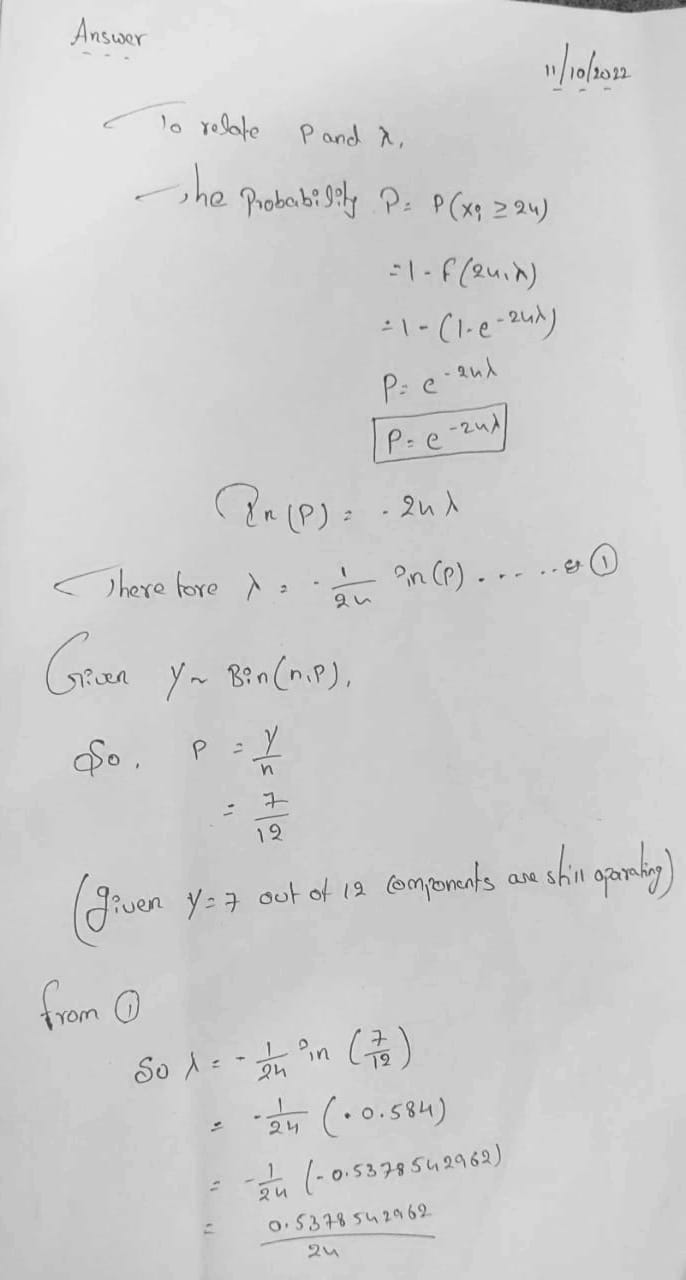At time t = 0, 12 identical components are tested. The lifetime distribution of each is exponential with parameter λ. The experimenter then leaves the test facility unmonitored. On his return 24 hours later, the experimenter immediately terminates the test after noticing that y = 7 of the 12 components are still in operation (so 5 have failed). Derive the mle of λ. [Hint: Let Y = the number that survive 24 hours. Then Y~ Bin(n, p). What is the mle of p? Now notice that p = P(X; ≥ 24), where X, is exponentially distributed. This relates to p, so the former can be estimated once the latter has been.] (Round your answer to four decimal places.) λ =
At time t = 0, 12 identical components are tested. The lifetime distribution of each is exponential with parameter λ. The experimenter then leaves the test facility unmonitored. On his return 24 hours later, the experimenter immediately terminates the test after noticing that y = 7 of the 12 components are still in operation (so 5 have failed). Derive the mle of λ. [Hint: Let Y = the number that survive 24 hours. Then Y~ Bin(n, p). What is the mle of p? Now notice that p = P(X; ≥ 24), where X, is exponentially distributed. This relates to p, so the former can be estimated once the latter has been.] (Round your answer to four decimal places.) λ =
MATLAB: An Introduction with Applications
6th Edition
ISBN:9781119256830
Author:Amos Gilat
Publisher:Amos Gilat
Chapter1: Starting With Matlab
Section: Chapter Questions
Problem 1P
Related questions
Question
100%
![At time \( t = 0 \), 12 identical components are tested. The lifetime distribution of each is exponential with parameter \( \lambda \). The experimenter then leaves the test facility unmonitored. On his return 24 hours later, the experimenter immediately terminates the test after noticing that \( y = 7 \) of the 12 components are still in operation (so 5 have failed). Derive the mle of \( \lambda \). [Hint: Let \( Y \) = the number that survive 24 hours. Then \( Y \sim \text{Bin}(n, p) \). What is the mle of \( p \)? Now notice that \( p = P(X_i \ge 24) \), where \( X_i \) is exponentially distributed. This relates \( \lambda \) to \( p \), so the former can be estimated once the latter has been.]
(Round your answer to four decimal places.)
\(\hat{\lambda} =\) [textbox]](/v2/_next/image?url=https%3A%2F%2Fcontent.bartleby.com%2Fqna-images%2Fquestion%2F1665bdf4-5411-4ca1-a903-736ef5c9444c%2F8479f259-9242-4239-a841-ac1d3e983a11%2F1ijsltd_processed.png&w=3840&q=75)
Transcribed Image Text:At time \( t = 0 \), 12 identical components are tested. The lifetime distribution of each is exponential with parameter \( \lambda \). The experimenter then leaves the test facility unmonitored. On his return 24 hours later, the experimenter immediately terminates the test after noticing that \( y = 7 \) of the 12 components are still in operation (so 5 have failed). Derive the mle of \( \lambda \). [Hint: Let \( Y \) = the number that survive 24 hours. Then \( Y \sim \text{Bin}(n, p) \). What is the mle of \( p \)? Now notice that \( p = P(X_i \ge 24) \), where \( X_i \) is exponentially distributed. This relates \( \lambda \) to \( p \), so the former can be estimated once the latter has been.]
(Round your answer to four decimal places.)
\(\hat{\lambda} =\) [textbox]
Expert Solution
Step 1

Step by step
Solved in 2 steps with 2 images

Recommended textbooks for you

MATLAB: An Introduction with Applications
Statistics
ISBN:
9781119256830
Author:
Amos Gilat
Publisher:
John Wiley & Sons Inc

Probability and Statistics for Engineering and th…
Statistics
ISBN:
9781305251809
Author:
Jay L. Devore
Publisher:
Cengage Learning

Statistics for The Behavioral Sciences (MindTap C…
Statistics
ISBN:
9781305504912
Author:
Frederick J Gravetter, Larry B. Wallnau
Publisher:
Cengage Learning

MATLAB: An Introduction with Applications
Statistics
ISBN:
9781119256830
Author:
Amos Gilat
Publisher:
John Wiley & Sons Inc

Probability and Statistics for Engineering and th…
Statistics
ISBN:
9781305251809
Author:
Jay L. Devore
Publisher:
Cengage Learning

Statistics for The Behavioral Sciences (MindTap C…
Statistics
ISBN:
9781305504912
Author:
Frederick J Gravetter, Larry B. Wallnau
Publisher:
Cengage Learning

Elementary Statistics: Picturing the World (7th E…
Statistics
ISBN:
9780134683416
Author:
Ron Larson, Betsy Farber
Publisher:
PEARSON

The Basic Practice of Statistics
Statistics
ISBN:
9781319042578
Author:
David S. Moore, William I. Notz, Michael A. Fligner
Publisher:
W. H. Freeman

Introduction to the Practice of Statistics
Statistics
ISBN:
9781319013387
Author:
David S. Moore, George P. McCabe, Bruce A. Craig
Publisher:
W. H. Freeman